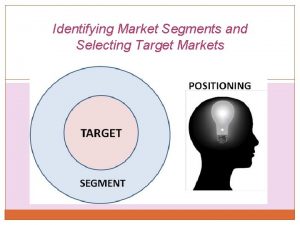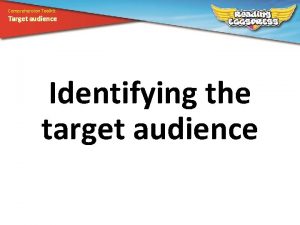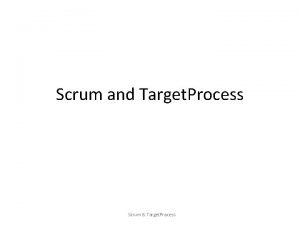Identifying a market need Chapter 6 Target market




















- Slides: 20

Identifying a market need Chapter 6

Target market Individuals or companies that are interested in your particular product or service and are willing and able to pay for it.

There main activities of the marketing concept n. Satisfy customer wants and needs n. Communicate with the customer n. Make a profit

Market Segmentation n. Dividing your market down into smaller segments to meet “niches”

Demographics n Data that describes personal things about people Age n Income n Ethnicity n Gender n - profession -Marital status -Family size

Psychographics n Data that describes a group in terms of their tastes, opinions, personality traits, and lifestyle habits n Like to garden, fish, hunt, play sports, etc.

Geographics n Based on where people live n City n County n State n Nation n Where all would you target for your business?

Customer Profile n A description of the characteristics of a person or company who would like buy your product or service. n Important because you will focus all your promotion efforts toward these people

Market Research n System for collecting, recording, and analyzing information about customers, competitors, goods, and services

Secondary data n Data that has already been collected (in published sources) Government publications such as U. S. Census, Chamber of Commerce n Web Sites for government and business (be sure is legitimate information) n Specialized magazines and journals – Newsweek, Entrepreneur n Newspaper articles and statistics n

Primary Data n. Data that is collected for the first time and usually for a specific purpose Disadvantage of primary data is it can be time-consuming and expensive to get

OBSERVATION n. Observe the number of people going into the place of business n. Observe purchases they make n. Observe good/bad things competition is doing

Focus Groups n In depth interviews with small groups of people (target market) n Get input regarding your business, product, new service idea n Usually can get more information from this primary data source

Questionnaires/Surveys n Most common type of primary data n Need to have questions regarding demographic, psychographic, and geographic information regarding your target market n Also information about the product and services to offer

Market Research Process n. Define the Question/Problem: What is it your are trying to find out? n. Select research method: Depends on the type of information need to gather

Market research (cont. ) n. Collect data: Good to have both secondary and primary sources of data n. Analyze the data: Your target market should be considered n. Draw conclusions: A plan of action (how use info. )

Types of competition n Direct Competition – Another business that sells similar products or services as another business (Wendys and Mc. Donalds) (Showplace Cinema and Somerset Cinema) n Indirect Competition – Competing against another business that makes only a small amount of money selling same or similar products and services n Bowling Alley and Finleys

Competing with large businesses n. Can keep larger quantities available n. They don’t rely on one single product line n. Usually have more resources for advertising

Competition (things to analyze) n Their prices n Location n Type of facility n Their strengths n Their weaknesses n Strategy – customers come to you instead of them

Keeping Customers Loyal n Providing Superior Customer Service n Responding to questions and concerns n More convenient hours than competition n Easy return policies n Store-specific credit cards n Personal note cards for birthdays, thank you cards n Frequent buyer programs
 Primary target market and secondary target market
Primary target market and secondary target market Adjective
Adjective Non identifying adjective clauses examples
Non identifying adjective clauses examples Identifying and non identifying adjective clauses
Identifying and non identifying adjective clauses Identifying market segments and targets chapter 9
Identifying market segments and targets chapter 9 Identifying market segments and targets chapter 9
Identifying market segments and targets chapter 9 Identifying market segments and targets chapter 9
Identifying market segments and targets chapter 9 Benefits of market segmentation targeting and positioning
Benefits of market segmentation targeting and positioning Definition of need analysis
Definition of need analysis 3 market need
3 market need Identifying market segments and targets
Identifying market segments and targets Segment invasion plan
Segment invasion plan Identifying market segments and targets
Identifying market segments and targets Market leader challenger follower nicher examples
Market leader challenger follower nicher examples Chapter 37 identifying career opportunities
Chapter 37 identifying career opportunities Identifying medical specialties chapter 7
Identifying medical specialties chapter 7 Chapter 13 lesson 1 identifying the substance of the gene
Chapter 13 lesson 1 identifying the substance of the gene Volvic definition
Volvic definition Toms target market
Toms target market Pringles market segmentation
Pringles market segmentation Gatorade brand positioning
Gatorade brand positioning




































